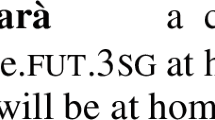Abstract
In this paper, I argue for two principles to determine the temporal interpretation of modal sentences in English, given a theory in which modals are interpreted against double conversational backgrounds and an ontology in which possible worlds branch towards the future, The Disparity Principle requires that a modal sentence makes distinctions between worlds in the modal base. The Non- disparity Principle requires that a modal sentence does not make distinctions on the basis of facts settled at speech time. Selection of the modal base will set these principles against each other, or allow for their cooperative interaction. For a root modal base, there is a conflict and disparity wins. The resulting interpretation is future. For a non-root modal base, the principles cooperate. Non-disparity determines a non-future interpretation and disparity requires the sentence to go beyond what is known by the speaker.
Similar content being viewed by others
References
Abusch D. (1998). Generalizing. tense semantics for future contexts. In S. Rothstein (Ed.), Events and grammar (pp. 13-33). Dordrecht: Kluwer Academic Publishers.
Clinque G. (1999). Adverbs and functional heads: A cross-linguistic perspective. Oxford, Oxford University Press
Condoravdi, C. (2001). Temporal interpretation of modals. In D. Beaver et al. (Eds.), Stanford papers on semantics (pp. 59-87). Stanford: CSLI Publications.
E-z geometry (n.d.). Retrieved January 5, 2006 from http://www.e-zgeometry.com/class/class2/2.3.4/ 2.3.4.htm
Enç, M. (1996). Tense and modality. In S. Lappin (Ed.), The handbook of contemporary semantic theory (pp. 345-358). Oxford: Blackwell.
Felkins, L. (2000). Paradoxes and dilemmas. Retrieved January 5, 2006 from http://perspicuity.net/ paradox/paradox.html
Groenendijk J., Stakhot M. (1975). Modality and conversational information. Theoretical linguistics. 2, 61–112
Kardes, F. R., Sanbanmatsu D. M. (2003). Omission neglect: The importance of missing information. Skeptical inquirer, March/April 2003. Retrieved January 5, 2006 from http:// www.findarticles.com/p/articles/2mi_m28433/is_2_27/ai_98252933
Kratzer A. (1977). What ”must” and ”can” must and can mean. Language and Philosophy. 1, 337– 355
Kratzer, A. (1981a). The notional category of modality. In H. Eikmeyer, H. Rieser (Eds.), Words, worlds, and contexts (pp. 38-74). Berlin: Walter de Gruyter.
Kratzer A. (1981b). Partition and revision: The semantics of counterfactuals. Journal of Philo- sophical Logic. 10, 201–216
Kratzer, A. (1991). Modality. In A. von Stechow, D. Wunderlich (Eds.), Semantics: An interna- tional handbook of contemporary research (pp. 639-650). Berlin: Walter de Gruyter.
Lightfoot D. (1979). Diachronic syntax. Cambridge, Cambridge University Press
Ogihara, T. (1989). Temporal reference in English and Japanese. PhD dissertation, University of Texas at Austria.
Ross, J. (1969). Auxiliaries as main verbs. In W. Todd (Ed.), Studies in philosophical linguistics, Series 1 (pp. 77-102).
Von Stechow, A. (1995). On the proper treatment of tense. In M. Simons, T. Galloway (Eds.), Proceedings from SALT 5 (pp. 362-386). Ithaca, N.Y.: CLC Publications.
Werner, T. (2003a). Deducing the future. In M. Kadowaki S. Kawahara (Eds.), Proceedings of the North East Linguistic Society (Vol. 33). Amherst: GLSA, University of Massachusetts.
Werner, T. (2003b). Deducing the future and distinguishing the past: Temporal interpretation in modal sentences in English, PhD dissertation, Rutgers University.
Author information
Authors and Affiliations
Corresponding author
Additional information
I would like to thank members of my dissertation committee, Veneeta Dayal and Mark Baker, for much assistance and discussion on issues in this paper. An anonymous reviewer for Natural Language Semantics has raised challenging points, and I thank Angelika Kratzer for very useful comments and examples. Mandy Simons has provided continuous support and encouragement. Most of all, my dissertation chair, Roger Schwarzschild, deserves thanks for all he has done in seeing this through. All shortcomings in the work are mine alone.
Rights and permissions
About this article
Cite this article
Werner, T. Future and non-future modal sentences. Nat Lang Semantics 14, 235–255 (2006). https://doi.org/10.1007/s11050-006-9001-8
Published:
Issue Date:
DOI: https://doi.org/10.1007/s11050-006-9001-8




